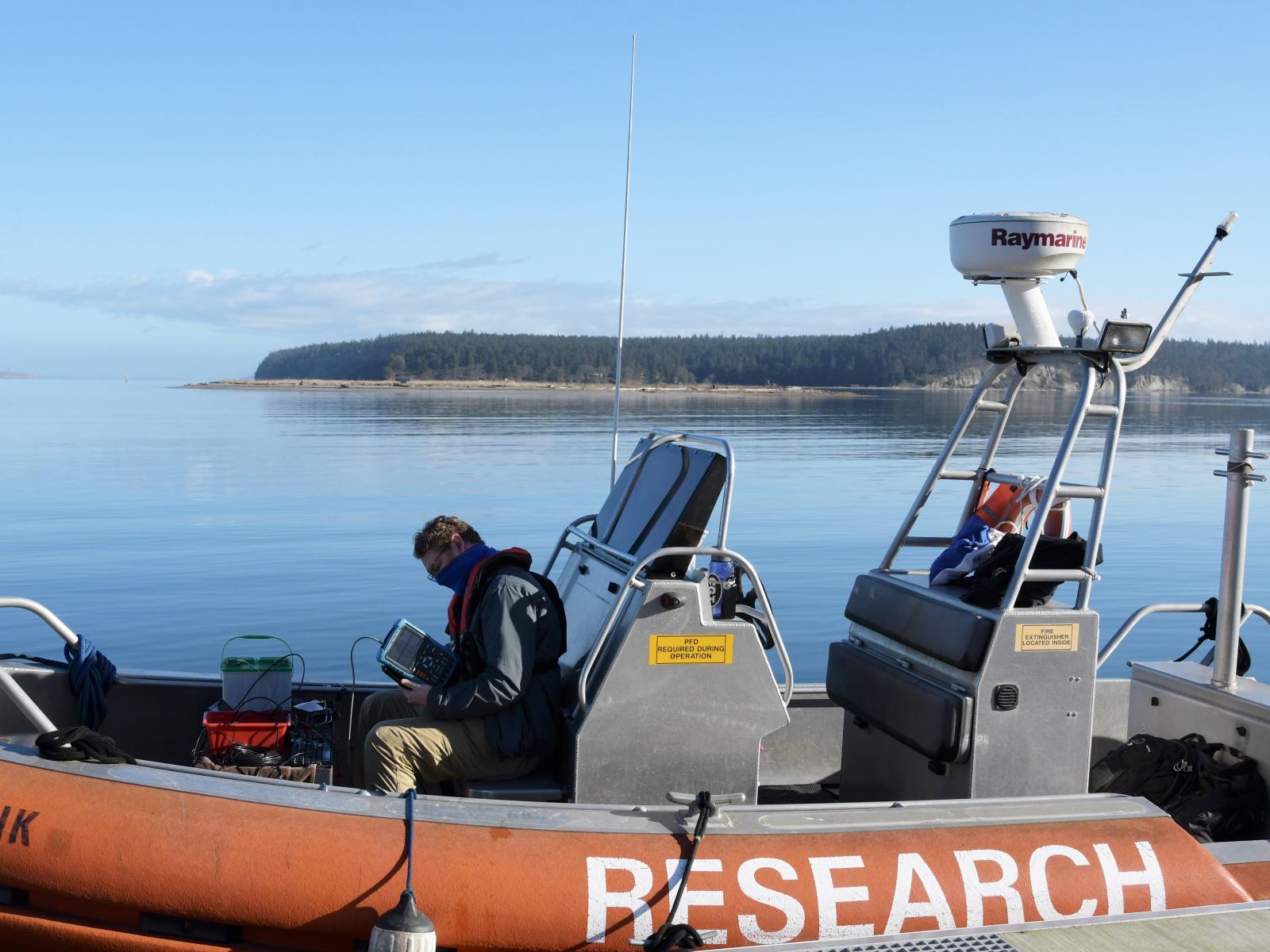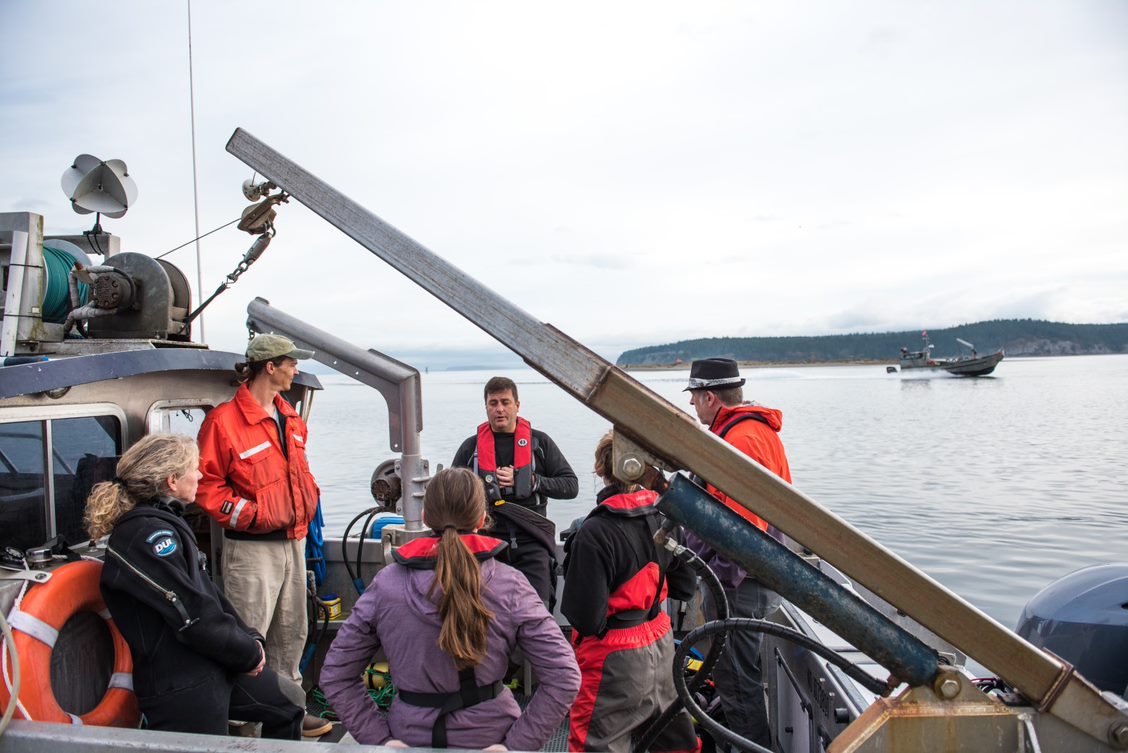Teamwork Makes the Dream Work: Triton’s Support of DOE-Funded Technology Projects

Nolann Williams in Sequim Bay testing an electromagnetic field detection technology for partners at the Woods Hole Oceanographic Institution.
(Photo by Alicia Amerson | Pacific Northwest National Laboratory)
The Triton Initiative works to understand the potential environmental impacts of marine energy systems to help advance this renewable energy industry. Building knowledge in this field of research isn't possible without innovative technology to monitor what dwells beneath the waves.
Since its beginnings, the U.S. Department of Energy (DOE) Water Power Technologies Office Triton Initiative has supported the development of environmental monitoring technologies funded through DOE's funding opportunity announcements (FOAs). This funding functions to advance the state of instrumentation and capabilities around marine energy devices, including current energy converters (like turbines) and wave energy converters (WECs). This FOA was a launchpad for seven technology projects focused on different aspects of monitoring a marine energy system. These technologies investigate stressors associated with marine energy devices including underwater noise, electromagnetic field measurements, studies of marine organism interactions, as well as benthic habitat mapping techniques, and integrated marine sensor packages to provide a holistic view of the marine environment.
Triton supports these seven FOA technology development projects:
- Integral Consulting, Inc. NoiseSpotter™
- University of Washington Drifting Acoustic Instrumentation SYstem (DAISY)
- BioSonics, Inc.
- Woods Hole Oceanographic Institution Electromagnetic Field Detection (WHOI EMF)
- Integral Consulting, Inc. Benthic Habitat Mapping
- University of Washington 3rd Generation Adaptable Monitoring Package (3G-AMP)
- Florida Atlantic University Unobtrusive Multi-Static LiDAR Imager (UMSLI)
From blueprint to in-water testing
Triton has supported these FOA projects since 2016 and has seen them move through technology readiness levels from concepts to commercially available technologies. Divided into three phases of technology development, the FOA projects were required to complete a prototype and initial testing at Pacific Northwest National Laboratory's (PNNL's) Marine and Coastal Research Laboratory (MCRL) in phase one, benchmark improvements and perform an additional in-water test for phase two, and make revisions to complete the third phase in which the technology is tested around an active marine energy device. The Triton team is there to support the projects through each phase, and testing at MCRL gives them access to a suite of research vessels, a scientific dive team, laboratories and facilities, and diverse technical expertise every step of the way.
The first phase of each of these projects involved preliminary technology development and baseline testing at MCRL. Phase two focused on technical development and benchmarked improvements before additional testing. Each project has made it to phase two, many are in the third and final iteration of testing, and one is complete. For the FOA projects, this means the technologies are ready for testing in high-energy environments at tidal or wave test sites, including the PacWave test site, the U.S. Navy Hawai'i Wave Energy Test Site (WETS), and around the CalWave wave energy converter at the Scripps Institution of Oceanography. There, they are deployed in unforgiving ocean environments to do what they are designed for: to monitor the environment around deployed marine energy devices. For the Integral Consulting, Inc. benthic habitat mapping project, this final test was a success, and the technology is now serving the marine energy industry as a commercially available device. Currently, the Triton team is supporting BioSonics, Inc. Integral Consulting, Inc. NoiseSpotter™, University of Washington 3G-AMP and DAISY, and the WHOI EMF as they prepare for these final demonstrations.
Triton’s fish biologist Garrett Staines has been with the FOA partners since phase one. He holds a valuable perspective on how each technology has advanced over the years and the importance of performing a series of readiness tests before making commercially available instruments. "During the testing phase (phase two), we learn about limitations, and what these technologies excel doing," says Staines, "with that testing and those realizations comes more efficient and effective monitoring." Environmental monitoring technology for marine energy impacts is not a one size fits all approach. The technology type and capabilities, oceanographic conditions, infrastructure, species of concern, data needs, and deployment costs differ significantly from site to site. This heterogeneity makes it essential to build technologies that are user friendly and can withstand various oceanographic conditions and adapt to the needs of a particular deployment.
Deployment of these monitoring technologies will allow for quick and practical testing of marine energy devices. "If developers have reliable, cost-effective monitoring technologies to use, this whole process becomes easier, and we can help the industry move closer to commercialization," adds Staines. Triton also connects FOA partners with marine energy developers to streamline monitoring. Projects like the University of Washington 3G-AMP and BioSonics, Inc. are working to integrate sensors into WECs themselves, so monitoring becomes part of the energy-producing system. Simultaneously testing a marine energy device for its power-producing potential and obtaining monitoring data is a way to collect the information needed to permit the future deployment of these devices.
Not only do the FOA projects help remove barriers to testing for marine energy, but they also help researchers build empirical datasets about potential environmental effects. " For industry to move forward we need real datasets. This is why the fieldwork aspect is so needed," says Staines. For example, testing the 3G-AMP at MCRL is crucial for improving the hardware and making sure it can stand up to harsh marine conditions at high-energy wave sites. Testing and data collection in the presence of an operational WECs will build the knowledge base to assure that the WEC has minimal to no impacts on the surrounding environment. Strengthening the knowledge base using these monitoring technologies is an important step for the industry to move forward.

The power of a team
One of the most significant components of Triton's FOA support is technical development. Electrical Engineer Nolann Williams has led the technical development and engineering support for four projects: BioSonics, Inc., Integral Consulting, Inc. benthic habitat mapping, Florida Atlantic UMSLI, and the WHOI EMF detector.
The bulk of Williams' contributions have been in applied research, where a FOA partner proposes an idea or requires his expertise to address a hardware or software challenge, and he works with them to find a solution. For example, BioSonics sought assistance from Williams in developing various components to facilitate the deployment of the Marine Life Observer technology—an innovative long-range acoustic instrument that monitors animals in close proximity to marine energy systems. This effort allows the BioSonics technology to be deployed with the C-Power SeaRAY wave energy converter at WETS to monitor sea life around wave energy converters.
To prepare for this deployment, BioSonics needed Williams to develop a positioning technology to remotely read the lander’s orientation and weight the instrument in highly energetic conditions to withstand up to a 20-year storm. Williams worked with BioSonics' in-house electrical and software engineers and brought on a team of electrical, mechanical, and aerospace engineers from PNNL to model the BioSonic lander and engineer solutions to technical problems. The team also helped develop an acoustically transparent shroud called the sonar dome to protect the most vulnerable parts of the lander from harsh marine conditions and biofouling. "A lot of these companies are small and work in novel research areas. Some of the problems we seek to solve are multidisciplinary and require a dozen engineering disciplines to find a solution," says Williams. PNNL can offer this breadth of expertise, allowing the projects to ask questions and go places that would otherwise not be possible. Williams adds, "one engineer is useful, but six engineers of different disciplines can build just about anything. This is the applied experience we offer that is hard to get elsewhere."
After several years of technology development, testing, and designing improvements, Williams is excited to see the Marine Life Observer be put to work observing and detecting marine life during the SeaRAY installation at WETS.
Whether it's designing and building a three-dimensional computer-generated model for a harbor seal target or innovating a magnetic field detector to support the WHOI EMF project, Williams has been a massive part of the technology development success of these FOA projects. For him, one of the best parts of this work is seeing the instruments undergo field tests. Williams explains, "the FOA awardees’ technologies generally focus on a single technical challenge, so we get to be part of the whole process, which allows us to help find solutions holistically. I love seeing things go into the field—I'm excited for BioSonics to use their sonar dome, and I can't wait to see how the WHOI detection device performs in the field. We can see the impact of these projects, and I know that Triton's contributions are helping pave the way to a better future."
Reflecting on the FOA-supported projects
While it has been rewarding to see the technologies grow and become instruments that are highly valuable to the advancement of the marine energy industry, a highlight for the Triton team is building partnerships with each of the FOA awardees. The partnerships provide opportunities outside this current scope of work, allow us to build new applications for existing technologies, explore concepts for new technologies, and combine expertise to support growth in the marine energy industry.
When asked what he has loved the most about working with FOA partners, Staines responded emphatically, "the grit and enthusiasm." Staines explains that whenever researchers develop and test new technology in a relatively new scenario, things can go wrong no matter how prepared you are. "We've dealt with delays due to fishing traffic, weather events, unexpected malfunctions—you name it. The fact that we have made it through phases one and two successfully with improvements to all the technologies is amazing." Staines adds, "That's the reality of testing in the ocean. Great ideas and grit are what led us to where we are now."
Both Staines and Williams look forward to supporting the FOA projects through final demonstration tests in the open ocean environment and seeing how the technologies will contribute to the industry's environmental monitoring knowledge base. In thinking back on his experience over the past five years, Staines reflects, "when you think big and long-term, it takes more than one entity to make an impact. You need more than a handful of researchers with a good idea; you need a site to test, facilities, and breadth of expertise. There are many ways to accomplish this, but FOA project support is a great example of how it can be done."
To make the FOA support possible, the U.S. Department of Energy, Water Power Technologies Office provided the PNNL Triton team with funds to support each project in each phase, with the idea that the government’s engineering, science, health and safety, and operations expertise and marine laboratory facilities would aid technology developers in a newly emerging energy space. As Triton completes the final phase of this multi-year effort, we want to express gratitude for all those who contributed to safe and excellent operations and making this project possible.
Read Triton's most recent publication
Read the recent Frontiers peer-reviewed publication, “Clearing a Path to Commercialization of Marine Renewable Energy Technologies Through Public–Private Collaboration,” highlighting this FOA partnership here.
Story written by Cailene Gunn
Subscribe to our monthly newsletter here.
Published: September 8, 2021